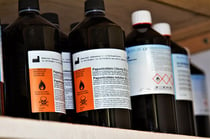 One of California’s longstanding amplifications of national environmental health and safety (EH&S) programs is provided by “Proposition 65.” I summarized these provisions here. As I described, the main thrust of this 1986 state enactment is to provide warnings about potentially hazardous chemicals, to customers, workers, and other “potentially exposed individuals." Prop 65 provides sample texts for warnings, including “safe harbor” text for product labels and in-store signage. After 30 years, the state is revising these safe harbors to be more informative. Revised safe harbor text became available for use August 30, 2016 and replace their expiring predecessors on August 30, 2018. Since we’re half way through this two year transition, it’s a good time to review.
One of California’s longstanding amplifications of national environmental health and safety (EH&S) programs is provided by “Proposition 65.” I summarized these provisions here. As I described, the main thrust of this 1986 state enactment is to provide warnings about potentially hazardous chemicals, to customers, workers, and other “potentially exposed individuals." Prop 65 provides sample texts for warnings, including “safe harbor” text for product labels and in-store signage. After 30 years, the state is revising these safe harbors to be more informative. Revised safe harbor text became available for use August 30, 2016 and replace their expiring predecessors on August 30, 2018. Since we’re half way through this two year transition, it’s a good time to review.
What Longstanding Safe Harbors Are Expiring?
Beginning 12 months after listing, no “person in the course of doing business” may knowingly and intentionally expose any individual (e.g., workers, consumers, or the general public) to the chemical without “clear and reasonable warning,” unless the exposure poses no “significant risk.” For decades, the state has allowed use of “safe harbor” warnings that few find very informative:
-
Consumer products: “WARNING: This product contains a chemical known to the State of California to cause [cancer] [birth defects or other reproductive harm]”
-
Fresh fruits, nuts, and vegetables: “WARNING: This product may contain a chemical known to the State of California to cause cancer, or birth defects or other reproductive harm]”
-
Alcoholic beverages: “WARNING: Drinking Distilled Spirits, Beer, Coolers, Wine and Other Alcoholic Beverages May Increase Cancer Risk, and, During Pregnancy, Can Cause Birth Defects”
-
Locations: “WARNING: This area contains a chemical known to the State of California to cause [cancer] [birth defects or other reproductive harm]”
-
Facilities where food is sold or served for immediate consumption: “WARNING: Chemicals known to the State of California to cause cancer, or birth defects or other reproductive harm may be present in foods or beverages sold or served here.”
What New Safe Harbors Are Becoming Available?
As of August 30, 2018, the following safe harbor provisions apply:-
The warning text includes the name of one or more of the listed chemicals in the consumer product or affected area for which the warning is being provided. If a warning addresses more than one endpoint (cancer and reproductive toxicity), it must include the name of one or more chemicals for each endpoint, or identify that the named chemical is listed for both endpoints.
-
Any consumer product exposure warning is prominently displayed on a label, labeling, or sign, and conspicuous enough compared with other words, statements, designs or devices to render the warning “likely to be read and understood by an ordinary individual under customary conditions of purchase or use.”
-
Any environmental exposure warning is provided in a conspicuous manner and under such conditions “as to make the warning likely to be seen, read, and understood by an ordinary individual in the course of normal daily activity.”
-
Any supplemental information is included only to the extent that it identifies the source of the exposure or provides information on how to avoid or reduce exposure to the identified chemical or chemicals (such supplemental information is not a substitute for the required warning content).
-
A consumer product exposure warning
-
An environmental exposure warning
-
An occupational exposure warning
-
A specific product, chemicals, and area exposure warning, for exposure via food, alcoholic beverages, food and non-alcoholic beverages, prescription drugs, dental care, wood dust, furniture products, diesel engines, passenger and off-road vehicles, recreational vehicles, enclosed parking facilities, amusement parks, petroleum products, service stations and vehicle repair facilities, and designated smoking areas
-
A warning of Bisphenol A exposure from canned and bottled foods and beverages.
Should People Outside California Care?
These provisions are clearly important inside California. In addition, state courts and federal Occupational Safety and Health Administration (OSHA) have upheld the incorporation of Proposition 65 warnings into worker information provided under HCS.More subtly, manufacturers from around the world have reformulated products to facilitate sales into California’s important market, and then sell these reformulated products to all markets. For example, wine bottles now come with plastic foil instead of lead, and nail polish remover no longer contains acetone. Many of these changes are invisible to consumers, but tend to reduce exposure risks.
Self-Evaluation Checklist
Does the organization manufacture, import, sell or use products with any chemical constituents listed under Proposition 65?Does the organization provide “clear and reasonable warning” of any listed constituents?
Does the organization limit its discharges of listed chemicals?
Does the organization identify Proposition 65-listed chemicals in its Hazard Communication Standard program?
Where Can I Go For More Information?
-
OEHHA Proposition 65 web portal
-
Webpage compiling additional warning information
-
Specialty Technical Publishers (STP) provides a variety of single-law and multi-law services, intended to facilitate clients’ understanding of and compliance with requirements. These include:
About the Author
Jon Elliott is President of Touchstone Environmental and has been a major contributor to STP’s product range for over 25 years. He was involved in developing 13 existing products, including Environmental Compliance: A Simplified National Guide and The Complete Guide to Environmental Law.
Mr. Elliott has a diverse educational background. In addition to his Juris Doctor (University of California, Boalt Hall School of Law, 1981), he holds a Master of Public Policy (Goldman School of Public Policy [GSPP], UC Berkeley, 1980), and a Bachelor of Science in Mechanical Engineering (Princeton University, 1977).
Mr. Elliott is active in professional and community organizations. In addition, he is a past chairman of the Board of Directors of the GSPP Alumni Association, and past member of the Executive Committee of the State Bar of California's Environmental Law Section (including past chair of its Legislative Committee).
You may contact Mr. Elliott directly at: tei@ix.netcom.com


